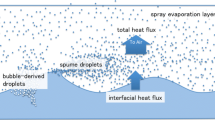Abstract
We performed numerical simulations of a 20 kT heavy explosion to predict the rise and diffusion of mushroom cloud after the atmospheric pressure is recovered around the burst point. We proposed a new formulation of governing equations based on the anelastic approximation and density weighted variables to implement the atmospheric stratification by employing potential temperature to account for the effect of atmospheric pressure variation in altitude. To validate the simulation results, we chose similar explosive yield cases performed at the Nevada sites to compare the mushroom cloud height and diameter. Parametric studies were performed by varying the grid size and global subgrid-scale coefficients, Cs, to find the appropriate value that guarantees reliability of simulation results. Based on the optimal simulation results, the cooling process of mushroom cloud and the suppressed ascending air currents around tropopause were investigated.
Similar content being viewed by others
Abbreviations
- C s :
-
Smagorinsky SGS coefficient
- C p :
-
Specific heat capacity
- f i :
-
Body force
- g :
-
Gravitational acceleration
- L x :
-
Domain size in x direction
- N x :
-
Grid number in x direction
- P :
-
Pressure
- P b :
-
Atmospheric pressure in altitude
- P D :
-
Hydrodynamic pressure
- P 0 :
-
Ground air pressure
- q j :
-
Residual flux
- R :
-
Gas constant of air
- s :
-
Entropy
- T :
-
Temperature
- T b :
-
Atmospheric temperature in altitude
- T i :
-
Temperature fluctuation
- u j :
-
Velocity in j direction
- X̄ :
-
Filtered variable
- X̃ :
-
Density-weighted variable
- αT :
-
Eddy diffusivity
- β :
-
Thermal expansion coefficient
- θ:
-
Potential temperature
- θb :
-
Atmospheric potential temperature in altitude
- θ:
-
Potential temperature fluctuation
- v T :
-
Eddy viscosity
- p :
-
Density
- p b :
-
Atmospheric density in altitude
- P 0 :
-
Ground air density
- p’ :
-
Density fluctuation
- T ij :
-
Residual shear stress
References
S. Song, Y. Li, C. Lee and J. Choi, Effect of surface conditions on blast wave propagation, Journal of Mechanical Science and Technology, 30 (9) (2016) 3907–3915.
Y. Kanarska, I. Lomov, L. Glenn and T. Antoun, Numerical simulation of cloud rise phenomena associated with nuclear bursts, Annals of Nuclear Energy, 36 (2009) 1475–1483.
I. Lomov, Simulation of dense and dilute multiphase compressible flows with Eulerian-Lagrangian approach, Proc. of 6th international Conference on Multiphase Flow, Leipzig, Germany (2007).
J. B. Bell, M. S. Day, C. A. Rendleman, S. E. Woosley and M. Ingale, Adaptive low Mach number modeling of nuclear flame microphysics, Journal of Computational Physics, 195 (2003) 677–694.
J. Kim, S. Kim, J. Choi and W. Sim, Simulation of blast wave propagation and mushroom cloud formation by a bomb explosion, 55th AIAA Aerospace Sciences Meeting and Exhibit Journal, Grapevine, Texas, USA (2017).
S. Glasstone and P. J. Dolan, The Effects of Nuclear Weapons, USDoD (1977).
A. W. Vreman, An eddy-viscosity subgrid-scale model for turbulent shear flow: Algebraic theory and applications, Physics of Fluids, 16 (10) (2004) 3670–3681.
H. A. Hawthrone, Compilation of Local Fallout Data from Test Detonations 1945–1962 Extracted from DASA 1251 Volume I-Continental U.S. Tests, Defense Nuclear Agency, Washington, D.C, USA (1979).
P. Bauweraerts and J. Meyers, On the feasibility of using large-eddy simulations for real-time turbulent-flow forecasting in the atmospheric boundary layer, Boundary-Layer Meteorology, 171 (2019) 213–235.
B. J. Hoskins and I. N. James, Fluid Dynamics of the Mid-Latitude Atmosphere, John Wiley & Sons, Ltd. UK (2014).
M. Germano, U. Piomelli, P. Moin and W. H. Cabot, A dynamic subgrid-scale eddy-viscosity model, Physics of Fluids A, 3 (1991) 1760–1765.
J. Smagorinsky, General circulation experiments with the primitive equations, Monthly Weather Review, 91 (3) (1963) 99–164.
M. M. Rai and P. Moin, Direct simulations of turbulent flow using finite-difference schemes, Journal of Computational Physics, 96 (1991) 15–53.
B. P. Leonard, A stable and accurate convective modelling procedure based on quadratic upstream interpolation, Computer Methods in Applied Mechanics and Engineering, 19 (1979) 59–98.
M. Hermann and G. Blanquart, Flux corrected finite volume scheme for preserving scalar boundedness in reacting large-eddy simulations, 43d AIAA Aerospace Sciences Meeting and Exhibit Journal, Reno, Nevada, USA (2005).
M. Frigo and S. G. Johnson, The design and implementation of FFTW3, Proc. of IEEE, 93 (2) (2005) 216–231.
R. J. Ritter, The Newsletter for America’s Atomic Veterans, National Association of Atomic Veterans, Inc., July (2013).
Acknowledgments
This research was supported by ADD (No. 17-113-601-026).
Author information
Authors and Affiliations
Corresponding author
Additional information
Recommended by Editor Yang Na
Sungjin Won received his B.S. (2014) from Yonsei University, Seoul, Korea in Mechanical Engineering. He is an integrated Ph.D. student in the Department of Computational Science & Engineering, Yonsei University, Korea. His research interests include large-eddy simulation, immersed boundary methods, and in the area of incompressible fluid dynamics.
Changhoon Lee received his B.S. (1985) and M.S. (1987) from Seoul National University, Seoul, Korea and Ph.D. (1993) from UC Berkeley, USA in Mechanical Engineering. He is a Professor in the Department of Computational Science & Engineering and Department of Mechanical Engineering, Yonsei University, Korea. His research interests include fundamentals of turbulence, particle-turbulence interaction, numerical algorithms, air pollution modeling and stochastic processes.
Rights and permissions
About this article
Cite this article
Won, S., Lee, C. Simulation of the mushroom cloud generated from a high-energy explosion using large-eddy simulation. J Mech Sci Technol 34, 2443–2453 (2020). https://doi.org/10.1007/s12206-020-0520-x
Received:
Revised:
Accepted:
Published:
Issue Date:
DOI: https://doi.org/10.1007/s12206-020-0520-x




